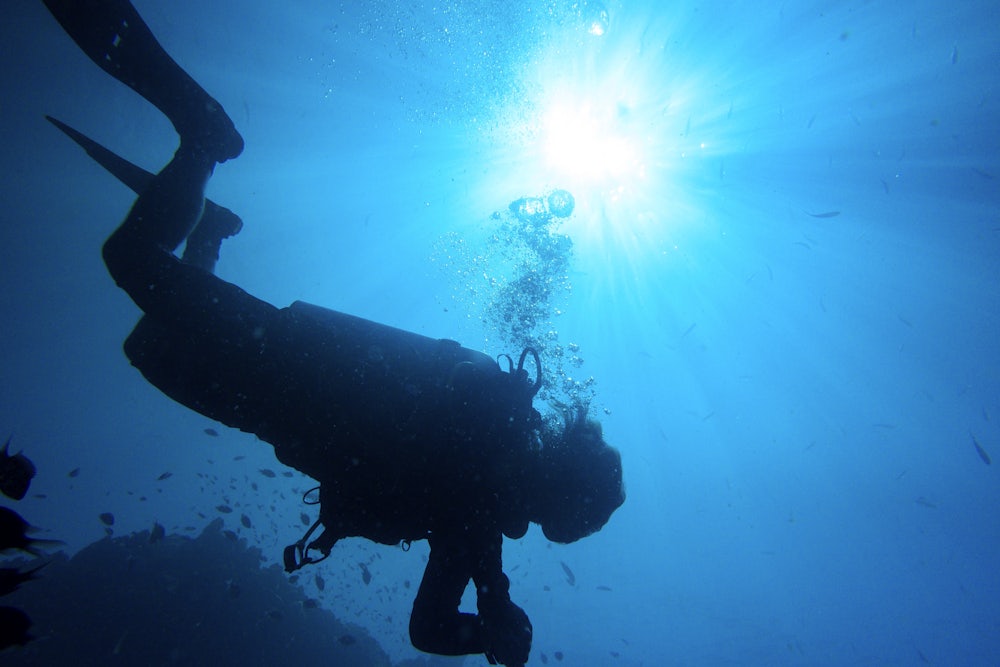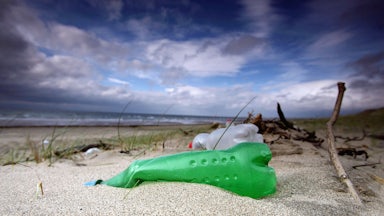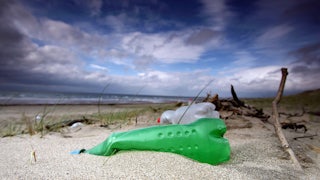In her 1951 book The Sea Around Us, Rachel Carson wrote that when she imagined the seafloor, “the single, overwhelming fact” that captured her imagination was “the accumulation of sediments.” The seafloor builds up through “the steady, unremitting, downward drift of materials from above, flake upon flake, layer upon layer,” over millions of years; geological change happens over time spans so long it is almost impossible to imagine. “The sediments,” she wrote, “are the materials of the most stupendous ‘snowfall’ the earth has ever seen.”

Carson was writing at a moment of unprecedented discovery. In 1952, scientists Noboru Suzuki and Kenji Kato of Hokkaido University climbed into an improbably small metal contraption named Kuroshio, dangled off the edge of legendary research vessel Oshoro Maru II, and investigated the phenomenon that Carson had described. While hanging around 50 meters below the surface, Suzuki and Kato photographed white matter falling. When the scientists analyzed their samples, it turned out to be made of dead phytoplankton and zooplankton, along with their bodily waste, bound in a sticky glue of molecules shed by organisms down to the size of bacteria. Noting Carson’s description, they dubbed the phenomenon “marine snow” in a 1953 paper.
This story of marine snow appears in Helen Scales’s new book, The Brilliant Abyss: Exploring the Majestic Hidden Life of the Deep Ocean, and the Looming Threat That Imperils It, a natural history of the seabed, which necessarily includes large sections on what we don’t know. The earth’s biosphere is, Scales explains, more than 95 percent made up of the deep sea: “Everything else—the forests and grasslands, rivers and lakes, mountains, deserts, and shallow coastal waters—is collectively outstripped in terms of sheer volume by those colossal reaches of the oceans that lie below the blue surface.” So the book’s purview is technically all of history, but the incredible paucity of interaction people have had with the deep sea means that most of the information here takes the form of news delivered as a dire, last-minute warning.
In the popular imagination, the deepest regions of the seas appear as the settings of sci-fi movies (The Abyss, Sphere, Underwater), which treat the seafloor more like outer space than a part of our planet. But this deep, dark region is connected to us via countless invisible processes, Scales argues, which keep the “balance in the atmosphere and climate … without which life on Earth would become unbearable or impossible.” That we cannot see these processes makes them more, not less, crucial to our planet’s survival, for “every living thing,” Scales writes, “needs the deep.”
How do you begin to picture the ocean? Scientists of the deep delineate layers within the water column, which Scales compares prettily to “layers of Jello poured into a tall sundae glass.” Below the sunlit zone (also called the epipelagic or euphotic), where familiar things swim and plants photosynthesize the sun’s light “into food for almost all the rest of ocean life,” we find the twilight, or mesopelagic zone, which spans from 660 feet down to 3,300. Then light disappears, and “the twilight zone gives way to the permanent dark of the midnight zone (or bathypelagic).” Here the water is 39 degrees Fahrenheit. Even further down, between 13,000 and 20,000 feet, the deep sea is “officially known as the abyss.”
The vast majority of the sea’s known species inhabit the sunlit zone, meaning that our knowledge of ocean life thins out into nothingness as we get further from the light. It’s at this midpoint between the deepest seafloor and “our” part of the ocean that Scales finds the edge of science, and the beginning of misunderstandings that have had devastating effects on the carbon budget of earth. “The expanses of the deep seabed, the abyssal plains and seamounts, canyons and trenches, plus all the water above them, constitute the single biggest living space on the planet,” she writes, and yet because we cannot see them we do not include them in our visions of climate emergency.
Marine snow represents exactly one such misunderstanding. It was long thought, Scales writes, that the snow was involved in a general downward motion: Zooplankton ate it, then fish lower down ate the zooplankton, and the jelly creatures scientists have seen also zipping around down there were beside the point. But this theory is partly the result, she explains, of the practice of dissecting animals to identify their last meals as a way to build the food web, which maps connections throughout large ecosystems: Jelly animals all but disappear in the guts of fish, and many simply liquefy when exposed to surface pressure.
The reality involves a lot more motion and a lot more digestion. In 2017, Scales writes, Anela Choy of the Monterey Bay Aquarium Research Institute discovered that the twilight zone jelly animals—such as the eerie, red-glowing siphonophore or the bell-shaped narcomedusa—were all constantly engaged in eating each other. They had no eyes or teeth, and “yet there they were, tangled up at the heart of the deep-sea food web.” Bring the narcomedusa Solmissus to the surface, however, and the once-voracious predator, Choy says, becomes “this clear gelatinous stuff that falls through your fingers.” Such creatures can only ever be observed while in their natural habitat, which is by definition inaccessible except by small, crawling submersibles, and very difficult to photograph. The jelly creatures, which are almost invisible except for their bioluminescent fireworks, are crucial to life in the deep sea, but we don’t quite understand what they are or how they work.
Such problems of perception are having an effect on our changing environment too devastating to understate. Scales cites a 2019 article by climate scientists in Nature arguing that the ocean functions as a “biological pump,” which “drives carbon storage in the deep ocean”; decomposing organisms drift toward the seafloor, rather than being released into the atmosphere. Gravity has been traditionally thought to do most of this work via “settling flux,” they wrote, with organic particles of marine snow drifting down from surface waters. But animals like lanternfish in fact regularly travel large distances up and down between pelagic layers, rising and eating and excreting, then plunging and being eaten. As Scales puts it, every day “as the sun sets around the world, a tremendous living wave races upward, as billions of zooplankton, fish, krill, squid, and jellies rise to hunt in the relative safety of the darkening shallows; when the sun reappears, they return to the darkness below, where they digest and defecate, releasing carbon consumed above.” If you could trace the path of every lanternfish on earth—and there are billions of them—you’d be drawing a map of what Scales calls “vital connections between the surface and the abyss.”
In other words, marine snow is merely one player in a vast web of predation that works to store carbon deep in the sea, which the article calls “particle injector pumps.” But if you have seen the word “lanternfish” recently, it is probably not because of its role in preserving the carbon balance of the earth but because, in 2017, “Norway issued forty-six new fishing licenses for the twilight zone,” with the intended outcome not of feeding anybody but of converting the lanternfish population into lucrative “nutraceuticals” that go into omega-3 supplements, then “yogurts and margarine, and the fish-oil pills more people are popping despite the lack of evidence that they do any good for the heart.” For these attempts at self-care, we are destroying a force that rivals gravity itself in regulating the climate.
Leaning into the mind-boggling scale of the disaster taking place in the deep seas, Scales alternates between marine stories of the extremely small, like the species of red worm that feasts exclusively on the skeletons of dead whales drifting downward through the ocean, and the numbingly big, as when she explains that the fact the oceans move is responsible for the dispersal of heat beating down from the sun at the equator. Currents bring heat up to the north, working in a complex system called the global conveyor belt, which relies on the way the deep sea behaves. As the melting of glaciers desalinates the deep sea, Scales writes, the likelihood of the conveyor belt in the Atlantic shutting down temporarily “sometime in the next hundred years” is about one in six.
That the oceans are getting hotter is such a primary fact about climate change that it’s easy to forget the details, especially because some of them present baffling ethical conundrums. For example, there’s a compound called halichondrin B that comes from sponges that grow on the seafloor in Japan; “more than one ton of the sponge was needed to produce a half-gram droplet.” Today, Scales notes, it’s still the only drug on the market that can prolong the lives of patients with late-stage metastatic breast cancer.
With such disorienting stakes, perhaps it’s no wonder that we prefer to live with a fictional view of the seabed. Apparently the reason Avatar 2 has taken so long to make is that James Cameron has been busy inventing new technology for using CGI in underwater scenes. His first big hit was also a deep-sea film: In The Abyss (1989), he had Ed Harris discover aliens deep underwater. That is not to mention the time Cameron piloted himself to the bottom of the Mariana Trench, seven miles below the surface of the Pacific, in 2012, and made a film about it, Deepsea Challenge 3D—a stunt Scales compares to billionaires paying to travel to space. Cameron’s is a megalomaniacal view of the deep sea, and it’s an oddly clean one, with little of the teeming, decomposing, mysterious life that Scales—or Rachel Carson—saw.
The Brilliant Abyss is a manifesto for change as much as it is a description of an ecological crisis. Its overall effect is not to clarify the waters—to create something as bright and blue as a Cameron scene—but to insist that what’s already down there matters, even or especially when it is hidden from our view.








